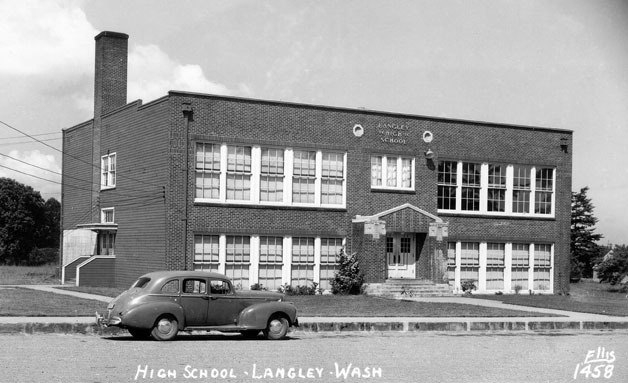About the series
Each week in May, the Record will publish a look back at Langley landmarks in a series researched by Linda Beeman, vice chairwoman of the Langley Historic Preservation Commission.
The series is part of the National Trust for Historic Preservation’s seventh annual National Preservation Month.
Orville Hunter can recall a few good things about Langley High School.
Location, location, location.
Hunter was part of the Class of 1948 at the venerable Langley landmark, now part of the campus for Langley Middle School.
Though the school had its quirks — “back in those days, you didn’t get a day off if the boiler broke; you kept your jacket on” — it did have downtown nearby.
More glorious to high school students at the time, however, was the nearby hamburger shack and candy store that was kitty-corner down the street toward town near Edgecliff.
But those were the days before an open campus, and students were expected to stay at school.
“You couldn’t leave [school] and go somewhere, good grief!” Hunter said.
Still, the attraction proved too great sometimes for students looking for a treat, despite being off-limits at lunchtime.
“You could get into trouble just going over there for a candy bar,” Hunter recalled.
High schoolers in those days were like ones from other generations. Rules were set, but not always kept.
“Being kids we did it anyway,” he said. “You got into trouble, just like anybody else.”
Langley High School now houses the library for LMS, but its beginnings were big, as the South End’s sole high school — a WPA effort to ease the impact of the Great Depression.
Ground-breaking took place in January 1935, and the two-story brick-clad structure was completed in the spring of 1936. It was the culmination of a half-century’s effort to educate Whidbey youngsters.
Since 1883, when the first school district was established, islanders struggled with the distance and challenging terrain children had to travel to reach their classrooms.
Most early schools were simple, one-room structures that accommodated 5-10 elementary-age students. Typically they were active for only three to four months during the late spring and early summer.
The school district purchased five acres of the middle school’s present site in 1914, opening an elementary and junior high school in a substantial building the following year.
Student numbers swelled during the 1920s and ’30s. By 1935, nearly all South End students were attending classes in Langley.
The purchase and donation of additional land west of the school enabled construction of the new brick building to handle the growing need.
It seems likely that William Mallis designed the building.
Mallis trained as an architect in Perth, Scotland before immigrating to the United States. He and his partner, Joseph DeHart, were prolific Seattle school designers of the time. The large, double-hung windows in the building resemble those he used at Lake City School in Seattle, and Mallis did design the adjacent classroom building in 1941.
An edition of the Whidbey Record in 1939 reports that a staff of seven taught high school students in their modern, seven-room building. The school was included on the University of Washington’s accredited list — “a distinct advantage for those students wishing to complete their education.” Five safe, modern buses serviced it. An athletic field, playgrounds and tennis court augmented the carefully kept gymnasium and were home to championship teams.
From the 1950s through the 1980s, the campus expanded and evolved swiftly. Officials increased the classroom building’s capacity, added the Spencer Building for shop and home economics and constructed a separate auditorium.
Since 1982, high school students have attended the Maxwelton Road high school building with middle school students remaining at the Langley campus.
Those interested in its past, however, will appreciate the original wood double doors that center the east façade. Art Deco capitals ornamented with fern motifs top the brick pilasters that frame them. Built-in library bookshelves, wood paneling in the hallways and the stairwell’s oak banisters evoke decades of use and remain a treasured reminder of school days past.
Record writer Brian Kelly contributed to this report.


